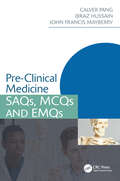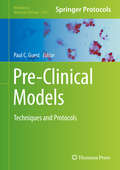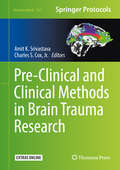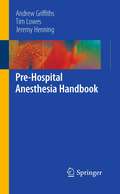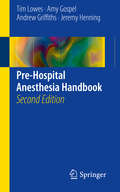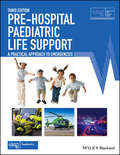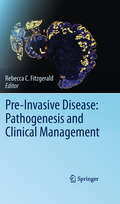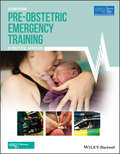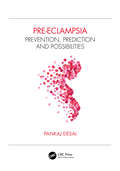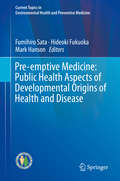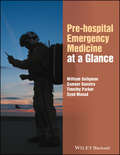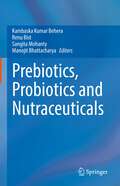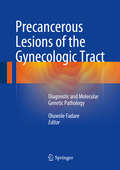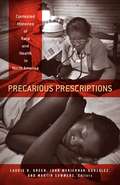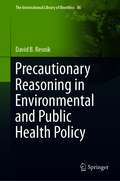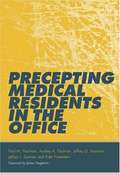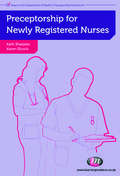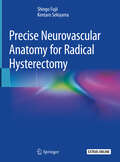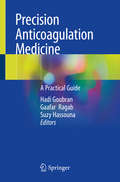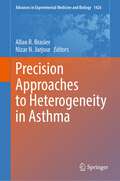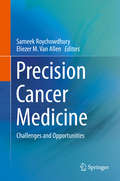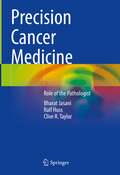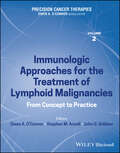- Table View
- List View
Pre-Clinical Medicine: SAQs, MCQs and EMQs (Medical Finals Revision Series)
by Calver Pang Ibraz Hussain John Francis MayberryFilling a gap for a pre-clinical phase revision guide, this book will help medics pass their intermediate exams in order to proceed to the clinical years. It is based on the SAQs, EMQs and MCQ school curriculum as set out by the GMC. By covering each module individually but also integrating other disciplines of medicine into the questions, it helps students to think laterally as well as thoroughly revising each module. With a minimum of 4 SAQs, 7 MCQs and 3 EMQs in each chapter, this book offers comprehensive revision practice as well as providing all the answers with clear explanations.
Pre-Clinical Models: Techniques And Protocols (Methods in Molecular Biology #1916)
by Paul C. GuestThis volume details reviews and protocols on the development and analysis of both cellular and animal-based pre-clinical models in a number of medical areas, including metabolic disorders, longevity, cancer, heart disease and psychiatric disorders. Written in the highly successful Methods in Molecular Biology series format, chapters include introductions to their respective topics, lists of the necessary materials and reagents, step-by-step, readily reproducible laboratory protocols, and tips on troubleshooting and avoiding known pitfalls.Authoritative and cutting-edge, Pre-Clinical Models: Techniques and Protocols aims to provide methods that describe the context of specific disease or therapeutic areas.
Pre-Clinical and Clinical Methods in Brain Trauma Research (Neuromethods #139)
by Amit K. Srivastava Charles S. CoxThis volume explores current viewpoints and knowledge gaps in the field of traumatic brain injury (TBI). The chapters in this book cover topics ranging from development of in vitro and animal TBI models, to diagnostic imaging and disease monitoring in patients. Designing pre-clinical and clinical trials is also discussed. In Neuromethods series style, chapters include the kind of detail and key advice from the specialists needed to get successful results in your laboratory.Practical and thorough, Pre-Clinical and Clinical Methods in Brain Trauma Research is a valuable resource for both scientists and clinical researchers interested in learning about important techniques and their applications in the field of TBI.
Pre-Hospital Anesthesia Handbook
by Andrew Griffiths Jeremy Henning Tim LowesPre-Hospital Anaesthesia is one of the most demanding interventions that can be made in the field. The exact incidence of failed intubation is difficult to quantify, but it is clear that it is higher than in hospital. Equally it is certain that anyone undertaking it should have clear instruction in the technique and a thorough understanding of all it entails. This handbook details the procedures, drugs and algorithms used by the crews of the Great North Air Ambulance who have been providing this life saving intervention since 2004. It draws on huge experience in the field and provides a spring board for any practitioner who wishes to take it on.
Pre-Hospital Anesthesia Handbook, 2nd Edition
by Andrew Griffiths Jeremy Henning Tim Lowes Amy GospelThis second edition handbook details new and improved procedures, current drugs and updated algorithms used by the crews of the Great North Air Ambulance who have been providing this life saving intervention since 2004. It will be of interest to pre-hospital care doctors and trainees, especially those studying for the GNAAS course. Pre-Hospital Anaesthesia is one of the most demanding interventions that can be made in the field. The exact incidence of failed intubation is difficult to quantify, but it is clear that it is higher than in hospital. Equally it is certain that anyone undertaking it should have clear instruction in the technique and a thorough understanding of all it entails.
Pre-Hospital Paediatric Life Support: The Practical Approach (Advanced Life Support Group)
by Advanced Life Support GroupThis practical book written especially for prehospital staff provides all the information needed to deal with children in life threatening situations before arriving at hospital. It is a complementary volume to the best-selling Advanced Paediatric Life Support
Pre-Invasive Disease: Pathogenesis and Clinical Management
by Rebecca C. FitzgeraldThis book is written by International experts in their field and should appeal to students and seasoned researchers, to scientists and to clinicians. No prior knowledge of the topic is required to appreciate this text and yet the book charters new territory. New perspectives are given on how our knowledge of cancer development might lead us to reconsider our clinical approach to early detection and prevention of cancer at an individual and population level.
Pre-Obstetric Emergency Training: A Practical Approach (Advanced Life Support Group)
by Advanced Life Support GroupPre-Obstetric Emergency Training: A Practical Approach, 2nd Edition Fully revised and now in full colour, the new edition of Pre-Obstetric Emergency Training (POET) will help practitioners identify and manage a range of time-critical obstetric emergencies, specifically in the pre-obstetric department setting. Providing structured examination and assessment techniques as an aid to determine what treatment should be provided before transport, this practical manual equips the practitioner with the knowledge necessary to save the mother and fetus in life-threatening circumstances before admission to the hospital. New to the second edition are chapters covering non-technical skills and communication, as well as complicated labour and delivery. Designed to accompany the associated Advanced Life Support Group training course, Pre-Obstetric Emergency Training serves as an authoritative guide for a range of pre-hospital practitioners dealing with specialist situations.
Pre-eclampsia: Prevention, Prediction and Possibilities
by Pankaj DesaiPre-eclampsia, a complication of pregnancy characterized by hypertension and/or edema and/or proteinuria, can have profound effects on the mother as well as the unborn fetus and even threaten their lives. Pre-eclampsia: Prevention, Prediction and Possibilities discusses the possible causes of the condition, its effects on various body systems, current methods of prediction, prevention, and treatment. What makes this book unique is its coverage of the deep intricacies of what causes Pre-eclampsia from examining the role of genetics and exosomes to lipids and their denaturation to endothelial denaturation and reperfusion damage. These extremely complex processes are thoroughly examined and then explained in a simplified way to enhance understanding. The latest concepts in color Doppler in prediction and current measures of prevention and treatment are explained at length. Overall, Pre-eclampsia will provide an updated resource for practicing obstetricians, research scientists, students and professionals involved in the care of pregnant subjects. Key Features Presents the etiopathology of Pre-eclampsia with recent research updates Establishes the link between Pre-eclampsia and other obstetric vasculopathies Covers individual systemic effects of the condition Explores the latest approach in prediction, prevention and treatment of Pre-eclampsia About the Author Dr. Pankaj Desai is a Consultant Obstetrics and Gynecology Specialist at Janani Maternity Hospital, Baroda, India. A prolific writer, he has contributed 43 chapters to different textbooks internationally and nationally. His outstanding academic contributions in the subject have been acknowledged and honored with 7 gold medals and 60 orations.
Pre-emptive Medicine: Public Health Aspects of Developmental Origins of Health and Disease (Current Topics in Environmental Health and Preventive Medicine)
by Mark Hanson Hideoki Fukuoka Fumihiro SataThis book reviews public health activities such as awareness campaigns, health education, and strategies for health policy based on recent epidemiological studies that provide insights into epigenetic processes caused by environmental factors and developmental plasticity. It provides the latest concepts and findings on the public health aspects of Developmental Origins of Health and Disease (DOHaD) research regarding early prevention of non-communicable diseases (NCDs). Attention is especially paid to key issues, including strategies for the effective prevention of NCDs in developmental stages of life and younger generations rather than in adults and the elderly.Public Health Aspects in Developmental Origins of Health and Disease (DOHaD) is structured in two parts; the first focuses on general remarks reviewing specific recommendations, practical methods and protocols, and future goals regarding public health aspects, while the second presents brief profiles of individual cohorts and consortia studies. This collection will benefit both new and established researchers, as well as students in the fields of epidemiology, clinical medicine, nutrition, education, and public health who are seeking comprehensive information on DOHaD and preemptive medicine.
Pre-hospital Emergency Medicine at a Glance
by William H. Seligman Sameer Ganatra Timothy Parker Syed MasudPre-hospital Emergency Medicine at a Glance offers healthcare students and trainees the essential theoretical knowledge and practical skills relevant to the provision of immediate care outside of the hospital. This concise text provides information on the principles of managing acutely unwell patients with life-threatening injuries at the scene of their accident, all in highly-illustrated double-page spreads to help explain key messages. This brand new title: Looks at the ways in which pre-hospital care is organised and delivered in the United Kingdom Explores some of the most common incidents that pre-hospital care teams attend to, including major trauma as well as cardiac arrests Includes an illustrated introduction to some of the many practical procedures pre-hospital care teams must be able to perform including resuscitative thoracotomy and rapid sequence induction of anaesthesia Takes into account the multi-disciplinary nature of the specialty Features a section on careers within pre-hospital care for doctors and paramedics Pre-hospital Emergency Medicine at a Glance is the perfect companion for medical students and junior doctors interested in learning more about pre-hospital care, as well as for paramedic students and paramedics who practise in the pre-hospital environment every day.
Prebiotics, Probiotics and Nutraceuticals
by Manojit Bhattacharya Kambaska Kumar Behera Renu Bist Sangita MohantyThe book titled ‘Prebiotics, Probiotics and Nutraceuticals’ is expected to direct many emerging research pathwaysneed at local and global levels for nutrition and food supplements for developing immunity for healthy life. This volume incorporates sixteen seminal papers on issue based research and their practical applications covering latest information and progress on different area of nutritional supplement research fight against disease. The book highlights the frontier issues and applications in nutritional biotechnology with wide coverage of the themes like Potentiality of Probiotics in Inactivation of Tetrodotoxin, Therapeutic Strategy for the Deterrence of COVID-19 with Relevance to Probiotics and Prospectives of Prebiotics, Probiotics and Synbiotics for Sustainable Development in Aquaculture.Plant based Bioactive compounds in Cancer Therapeutics, Recent Trends in Natural Medicines and Nutraceuticals Research, Probiotics as efficacious therapeutic option for treating gut-related diseases: molecular and immune-biological perspectives, The progressive development of probiotics, prebiotics, synbiotics research, and its multipurpose use in the ornamental fishery, The commercial perspective of probiotics, and bioremediating components in aquaculture pond management: A Case Study andPrebiotics as promising therapeutics for treating gut-related disorders : Biochemical and Molecular Perspectives. Prebiotics and Probiotics as Functional Foods: Prospect and Promises in Metabolic Diseases, Implications of probiotics and prebiotics on immune functions. Recent Trends in Natural Medicines and Nutraceuticals Research, Nutraceuticals are alternative to modern medicines, Socio-Economic Study of Prospective of probiotic, prebiotic and synbiotic for sustainable development of aquaculture in Indian Sunderban. This book will be very useful for the scholars, biotechnologists, agricultural scientists, nutritionist, medical doctors, researchers, teachers and students in the emerging field of biotechnology.
Precancerous Lesions of the Gynecologic Tract
by Oluwole FadareThis volume provides a concise yet comprehensive overview of precancerous lesions and gynecologic tract cancers. Each section discusses the historic evolution of a precancerous lesion, its epidemiology, the nature of the published evidence that supports its characterization as a precancerous lesion, and gives a detailed description of morphologic, immunophenotypic and molecular properties, and patient outcomes. The volume also features 2 separate chapters on the clinical management of precancerous lesions of the gynecologic tract as a well as the cytopathology of cervical precancerous lesions. Lavishly illustrated and written by some of the foremost experts in the field, Precancerous Lesions of the Gynecologic Tract: Diagnostic and Molecular Genetic Pathology is a definitive account of precancerous lesions of the gynecologic tract and is a valuable resource for pathologists, oncologists, and gynecologists.
Precarious Prescriptions: Contested Histories of Race and Health in North America
by Laurie B. Green, John McKiernan-González, and Martin SummersIn Precarious Prescriptions, Laurie B. Green, John Mckiernan-González, and Martin Summers bring together essays that place race, citizenship, and gender at the center of questions about health and disease. Exploring the interplay between disease as a biological phenomenon, illness as a subjective experience, and race as an ideological construct, this volume weaves together a complicated history to show the role that health and medicine have played throughout the past in defining the ideal citizen.By creating an intricate portrait of the close associations of race, medicine, and public health, Precarious Prescriptions helps us better understand the long and fraught history of health care in America.Contributors: Jason E. Glenn, U of Texas Medical Branch at Galveston; Mark Allan Goldberg, U of Houston; Jean J. Kim; Gretchen Long, Williams College; Verónica Martínez-Matsuda, Cornell U; Lena McQuade-Salzfass, Sonoma State U; Natalia Molina, U of California, San Diego; Susan M. Reverby, Wellesley College; Jennifer Seltz, Western Washington U.
Precautionary Reasoning in Environmental and Public Health Policy (The International Library of Bioethics #86)
by David B. ResnikThis book fills a gap in the literature on the Precautionary Principle by placing the principle within the wider context of precautionary reasoning and uses philosophical arguments and case studies to demonstrate when it does—and does not—apply. The book invites the reader to take a step back from the controversy surrounding the Precautionary Principle and consider the overarching rationales for responding to threats to the environment or public health. It provides practical guidance and probing insight for the intended audience, including scholars, students, journalists, and policymakers.
Precepting Medical Residents in the Office
by Paul M. Paulman Audrey A. Paulman Francesca Forzano Jeff Susman Kate FinkelsteinThis work includes a foreword by James Stageman. 'This book has been produced to serve as a resource for community physicians who bring medical residents into their practices and train them in their offices. This book has been designed with the busy community physician in mind. Each chapter is intended to serve as a practical, concise, easily read, stand alone resource on the topic covered.' - Paul M. Paulman, Audrey A. Paulman, Jeff D. Harrison, Jeff Susman and Kate Finkelstein, in the Preface. 'A comprehensive handbook for precepting residents. Although modern technology can change the way in which students acquire knowledge and skills, there is no substitute for a true mentor. In medicine, perhaps more than in any other profession, our mentors have always enjoyed a special place in our hearts and minds. Although some professional athletes may contend that "I am not a role model", there is no doubt where you and I, as preceptors, stand on this issue. We are role models. We are mentors and upon us falls the responsibility to prepare tomorrow's physicians for careers in public service that we can only begin to comprehend.' - James Stageman, in the Foreword. Written by practicing and academic physicians with decades of experience, this book is the only complete guide written specifically for busy community physicians who teach medical residents in their office. Each chapter is short, concise, easily read and serves as a stand alone reference on the topic covered. Its contents include: identifying learning needs and creating the learning environment; setting goals and objectives, providing feedback and evaluating residents; involving your office staff in teaching and integrating practice management into the preceptorship; preparing the community and practice for the residents and collaborating with local hospitals; documenting supervision and addressing ACGME competencies; and dealing with regulatory bodies and addressing liability issues. This book is an invaluable guide for practicing physicians teaching medical residents in the workplace, particularly those in family medicine, internal medicine and pediatrics, and a useful reference for residency program directors.
Preceptorship for Newly Registered Nurses (Post-Registration Nursing Education and Practice LM Series)
by Kath Sharples Karen ElcockNewly qualified nurses can find their first year of practice a daunting experience. This book is specifically written to support new nurses through the demands of their preceptorship year. Each chapter provides friendly and practical support on the main areas of development needed for new nurses to become confident practitioners. The book is also designed for use on formal preceptorship programmes and covers each of the areas for professional development outlined in the Department of Health's new Preceptorship Framework (2010). Packed with activities, case studies and down to earth advice, this book provides essential support for the newly registered nurse.
Precious Blood: A Novel (Edward Jenner Series #1)
by Jonathan HayesThe nightmare of 9/11 left New York City medical examiner Edward Jenner shattered and emotionally scarred. He thought he'd turned away from forensics—and life—for good, but the mutilation murder of a college student is pulling him back. The body of a young woman, nailed to the wall of her East Village apartment, has Jenner convinced that there's a serial killer prowling the city—and a second horrific murder only confirms his most terrible fears. The desperate hunt for a psychopath—and Jenner's troubling obsession with a beautiful, frightened woman who could be the maniac's next victim—is pushing the forensic expert to the limits of his physical and mental endurance.But as the shadows deepen it gets harder to tell who is the hunter and who is the prey. And which one will live . . . and who will die.
Precious Cargo: My Year of Driving the Kids on School Bus 3077
by Craig DavidsonFor readers of Kristine Barnett's The Spark, Andrew Solomon's Far From the Tree and Ian Brown's The Boy in the Moon, here is a heartfelt, funny and surprising memoir about one year spent driving a bus full of children with special needs.With his last novel, Cataract City, Craig Davidson established himself as one of our most talented novelists. But before writing that novel and before his previous work, Rust and Bone, was made into a Golden Globe-nominated film, Davidson experienced a period of poverty, apparent failure and despair. In this new work of riveting and timely non-fiction, Davidson tells the unvarnished story of one transformative year in his life and of his unlikely relationships with a handful of unique and vibrant children who were, to his initial astonishment and bewilderment, and eventual delight, placed in his care for a couple of hours each day--the kids on school bus 3077. One morning in 2008, desperate and impoverished while trying unsuccessfully to write, Davidson plucked a flyer out of his mailbox that read, "Bus Drivers Wanted." That was the first step towards an unlikely new career: driving a school bus full of special-needs kids for a year. Armed only with a sense of humour akin to that of his charges, a creative approach to the challenge of driving a large, awkward vehicle while corralling a rowdy gang of kids, and unexpected reserves of empathy, Davidson takes us along for the ride. He shows us how his evolving relationship with the kids on that bus, each of them struggling physically as well as emotionally and socially, slowly but surely changed his life along with the lives of the "precious cargo" in his care. This is the extraordinary story of that year and those relationships. It is also a moving, important and universal story about how we see and treat people with special needs in our society.From the Trade Paperback edition.
Precise Neurovascular Anatomy for Radical Hysterectomy
by Shingo Fujii Kentaro SekiyamaThis extraordinary monograph provides the precise neurovascular anatomy involved in open-abdominal radical hysterectomies, information that is essential for surgeons. For the surgical treatment of invasive cervical cancer, E. Wertheim reported the first systematic data on radical hysterectomy in the early 20th century. While Okabayashi’s radical hysterectomy technique, which modified Wertheim’s approach, later became the mainstream choice for the treatment of Stage Ib and IIb cervical cancer in Japan, the anatomy of the pericervical area is still not fully understood. The recent spread of laparoscopic surgery and robotic surgery also requires a clear grasp of the anatomy of the blood vessels in the connective tissues of the female pelvis.Precise Neurovascular Anatomy for Radical Hysterectomy provides comprehensive information on the surgery and surgical steps necessary for the complete preservation of the nerve function of the urinary bladder and rectal-nerve-sparing radical hysterectomy. All illustrations presented in this book were drawn by the first author – a pioneering gynecological surgeon – and reflect real-world procedures. Plus, a total of 4 hours of supplementary videos introducing the history of hysterectomy, the concept and precise anatomy of nerve-sparing radical hysterectomy, and live surgery provide valuable visual aids for professionals. All anatomical features described are essential and practical, and have been refined based on the latest clinical practice. As such, the book offers a valuable resource for all gynecological surgeons and general surgeons with an interest in gynecological oncology.
Precision Anticoagulation Medicine: A Practical Guide
by Gaafar Ragab Hadi Goubran Suzy HassounaThis book provides a practical guide to the use of novel and conventional anticoagulants for a variety of medical conditions and patients profiled. It reviews data for selecting the most appropriate medication for a given presentation based on a patient’s background while highlighting current best practices. Chapters discuss the choice of agents and optimum duration of therapy while including the relevant literature review and evidence. Specific sections focus on the use of anticoagulants in patients with cardiovascular disease, autoimmune and rheumatologic disorders, antiphospholipid syndrome, cancer, and in the surgical contexts. The book also examines anticoagulation in pregnant and lactating women, pediatric and elderly populations, and patients with extreme weights. Intended for use in daily practice, Precision Anticoagulation Medicine - A Practical Guide is an essential resource for physicians and related professionals, residents, fellows, and graduate students in hematology, cardiology, rheumatology, oncology, surgery, anesthesiology, and intensive care.
Precision Approaches to Heterogeneity in Asthma (Advances in Experimental Medicine and Biology #1426)
by Allan R. Brasier Nizar N. JarjourAsthma is a common chronic respiratory disease that causes substantial morbidity and has been challenging to treat due to its heterogeneous onset, environmental triggers, severity, and treatment response. To update the field on the rapid advances in this field, Precision Approaches to Heterogeneity in Asthma follows its highly successful predecessor, Heterogeneity in Asthma. In this new volume, noted authorities Allan R Brasier and Nizar N Jarjour and a cadre of leaders in the field incorporate new work advancing our understanding of phenotypes (endotypes) of disease, regional variations in ventilation, systems approach to analyzing the findings from studies of inducible phenotypes, and emerging results of biomarker-informed clinical trials. This work will facilitate our current understanding of the spectrum of disease etiology, prognosis, and the likelihood of responding to the range of available therapeutic interventions.
Precision Cancer Medicine: Challenges and Opportunities
by Sameek Roychowdhury Eliezer M. Van AllenGenomic sequencing technologies have augmented the classification of cancer beyond tissue of origin and towards a molecular taxonomy of cancer. This has created opportunities to guide treatment decisions for individual patients with cancer based on their cancer’s unique molecular characteristics, also known as precision cancer medicine. The purpose of this text will be to describe the contribution and need for multiple disciplines working together to deliver precision cancer medicine. This entails a multi-disciplinary approach across fields including molecular pathology, computational biology, clinical oncology, cancer biology, drug development, genetics, immunology, and bioethics. Thus, we have outlined a current text on each of these fields as they work together to overcome various challenges and create opportunities to deliver precision cancer medicine. As trainees and junior faculty enter their respective fields, this text will provide a framework for understanding the role and responsibility for each specialist to contribute to this team science approach.
Precision Cancer Medicine: Role of the Pathologist
by Clive R. Taylor Ralf Huss Bharat JasaniThis book describes the changing role of pathology in aiding reproducible and accurate patient selection for predictive cancer therapy. Particular attention is given to the clinical application of cutting-edge cancer biomarkers to accurately select patients for targeted cancer therapy and how artificial intelligence can improve the precision of treatments. The advent and basis of predictive cancer care, the role of pathologists in translational cancer research, the analysis of cancer samples, the management of biopsy results, and the accuracy of biopsy results are also discussed. Precision Cancer Medicine: Role of the Pathologist details how pathologists can use the latest biomarkers and apply artificial intelligence technology in cancer diagnosis and management. It is also relevant to oncologists and medical practitioners involved in cancer management seeking an up-to-date resource on the topic.
Precision Cancer Therapies, Immunologic Approaches for the Treatment of Lymphoid Malignancies: From Concept to Practice
by John G. Gribben Stephen M. Ansell Owen A. O'ConnorPresents timely and authoritative information on the development of precision cancer therapies as applied to hematologic malignancies The Precision Cancer Therapies series focuses on how to understand and translate fundamental basic science into information that can be directly applied to patients to advance care. Each volume of the series integrates the relevant biological concepts and principles necessary for translating this science to practitioners of this science. Precision Cancer Therapies, Volume Two, focuses on sophisticated immunotherapies targeting cancers affecting the blood, bone marrow, and lymph nodes. Edited and authored by the foremost authorities in the field, this comprehensive reference text covers targeting of cell surface receptors, antibody-drug conjugates (ADC), targeting immune checkpoint, targeting macrophages, EBV-directed immunotherapies, tumor-associated antigens (TAA), and chimeric antigen receptor T-cells (CAR-T). Divided into nine sections, Volume Two includes an overview of the history of immunotherapy development in cancer, as well as a concluding section addressing the mechanistic basis and role of immunomodulatory drugs, analytical tools to quantitate immune-mediated effects, and other topics in immunotherapy. Chapters on specific therapeutics or therapeutic classes include a basic explanation of the underlying pathway and target, the pharmacology of the drug/class, relevant preclinical and clinical data, and discussion of clinical management and potential predictive biomarkers of response. This book also: Delivers a definitive, state-of-the-art review of the relevant biology and its importance in the broader context of cancer biology Focuses on agents that mediate cell killing in lymphoma through a variety of immunologic mechanisms Covers FDA-approved drugs and their indications, as well as drugs currently in development Provides information on monotherapy and combination therapy, summary tables of trials, and discussion of toxicity and efficacy Includes boxed sections highlighting major unique points about the information in the chapter Precision Cancer Therapies, Volume Two: Immunologic Approaches for the Treatment of Lymphoid Malignancies, From Concept to Practice is an indispensable resource for medical, scientific, and allied medical professionals, advanced students, and interested general readers with background knowledge in the subject.
